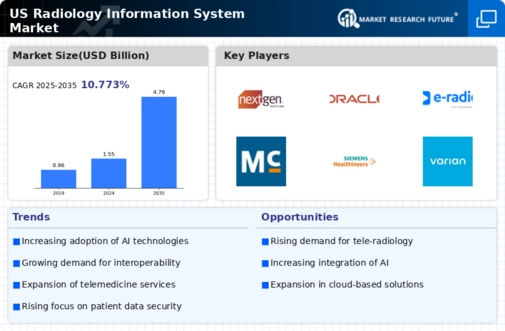The competitive insights of the US Radiology Information System Market reveal a dynamic landscape characterized by rapid technological advancements and evolving healthcare demands. This market serves as a vital component of healthcare infrastructure, enabling efficient management of radiology data, enhanced workflows, and improved patient care.
Companies operating within this space focus on innovative solutions that leverage artificial intelligence, machine learning, and cloud-based systems to optimize radiological services. The increasing emphasis on interoperability, regulatory compliance, and patient engagement drives companies to distinguish themselves by developing tailored systems that enhance diagnostic accuracy and operational efficiency.
As the demand for advanced radiological services grows, players in the market are also exploring strategic partnerships and collaborations to strengthen their market position and broaden their service offerings.
Key Company Analysis
Allscripts
Allscripts stands out in the US Radiology Information System Market due to its robust health information technology solutions tailored for radiology practices. The company has established a significant market presence through its comprehensive Electronic Health Record (EHR) systems that integrate radiology workflows, offering seamless communication between radiologists and other healthcare providers.
Allscripts has developed strong relationships with healthcare organizations, leveraging its extensive experience in managing radiology data to enhance diagnostic processes and improve patient outcomes. The company's innovative solutions, such as enhanced reporting capabilities and data analytics, are critical in optimizing the workflow of radiology departments.
Allscripts' commitment to continual product enhancements and user-friendly interfaces has garnered positive feedback from clinicians, further solidifying its strengths within this competitive landscape.
NextGen Healthcare
NextGen Healthcare also plays a key role in the US Radiology Information System Market, focusing on providing integrated solutions to enhance medical practice efficiency. The company specializes in electronic health records and practice management, with offerings that specifically cater to radiology needs.
NextGen Healthcare’s key products include powerful radiology software that facilitates streamlined imaging orders and reports, promoting consistency and accuracy in patient care. The company's significant presence in the market is bolstered by its strategies around mergers and acquisitions, allowing it to expand its product portfolio and enhance its technological capabilities.
NextGen Healthcare’s strengths lie in its commitment to fostering innovation and ensuring interoperability, making it a dependable partner for healthcare providers in optimizing their radiology departments. Through these initiatives, NextGen Healthcare continues to make impactful strides within the US market, emphasizing its role in advancing radiological practices.


















